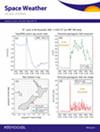A Novel Ionospheric Inversion Model: PINN-SAMI3 (Physics Informed Neural Network Based on SAMI3)
IF 3.7
2区 地球科学
引用次数: 0
Abstract
Purely data-driven ionospheric modeling fails to adequately obey fundamental physical laws. To overcome this shortcoming, we propose a novel ionospheric inversion model, Physics-Informed Neural Network based on fully physical models SAMI3 (PINN-SAMI3). The model incorporates the governing equations of the ionospheric physical model SAMI3 into the neural network to reconstruct the temporal-spatial distribution of ionospheric plasma parameters. The objective of this study is to investigate the feasibility of integrating physical models with machine learning for ionospheric modeling. The PINN-SAMI3 framework enforces physical laws through the multiple ion species of continuity, momentum, temperature equations in the magnetic dipole coordinate system. The simulation results show that if sparse ion densities are used as training data, it is possible to retrieve ionospheric electron densities, ion velocities and ion temperatures, respectively. The optimal physical constraints have been also investigated for different inversion quantities. Furthermore, the impact of incorporating E × B velocity terms on inversion results during the periods of ionospheric calm and geomagnetic storm is analyzed. The PINN-SAMI3 achieves good inversion results even using sparse data in comparison to the traditional artificial neural networks (ANN). The framework will contribute to advance the future space weather prediction capability with artificial intelligence (AI).新型电离层反演模型:PINN-SAMI3(基于 SAMI3 的物理信息神经网络)
纯粹由数据驱动的电离层建模无法充分遵循基本物理定律。为了克服这一缺陷,我们提出了一种新的电离层反演模型,即基于完全物理模型 SAMI3 的物理信息神经网络(PINN-SAMI3)。该模型将电离层物理模型 SAMI3 的支配方程纳入神经网络,以重建电离层等离子体参数的时空分布。本研究的目的是调查将物理模型与机器学习相结合用于电离层建模的可行性。PINN-SAMI3 框架通过磁偶极坐标系中的多离子连续性、动量、温度方程来执行物理定律。模拟结果表明,如果使用稀疏离子密度作为训练数据,就有可能分别检索出电离层电子密度、离子速度和离子温度。还研究了不同反演量的最佳物理约束条件。此外,还分析了在电离层平静期和地磁风暴期加入 E × B 速度项对反演结果的影响。与传统的人工神经网络(ANN)相比,即使使用稀疏数据,PINN-SAMI3 也能获得良好的反演结果。该框架将有助于利用人工智能(AI)提高未来空间天气预报能力。
本文章由计算机程序翻译,如有差异,请以英文原文为准。
求助全文
约1分钟内获得全文
求助全文

 求助内容:
求助内容: 应助结果提醒方式:
应助结果提醒方式:


